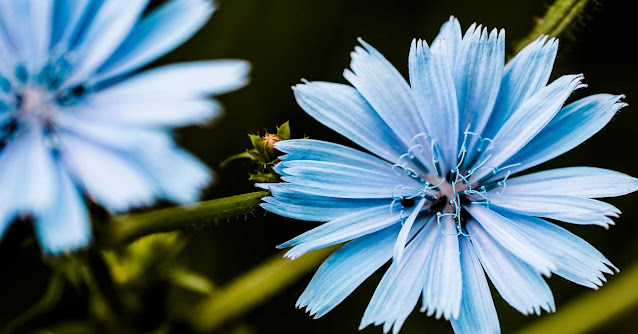यो ३ फिट अग्लो
गोब्रे पालुङ्गोसमान पात चम्किलो निलो
फुल्ने उष्ण तथा समशीतोष्ण
क्षेत्रमा पाइन्छ । गुण-धर्म
केही तितो र मिठो
स्वाद, स्वभाव शीतल । औषधीय
उपयोग : यसको साग खाँदा
मृगौलालाई शक्ति दिन्छ, मूत्रकष्टमा लाभ गर्छ, पित्तरोग
र गर्मीज्वर सन्चो गराउँछ, विषमज्वर र मलेरियाज्वरमा फाइदा
पुऱ्याउँछ, दम-खोकीमा लाभ
दिन्छ । सुकेको पात
धूलो १/१ चम्चा
३-५ पटक ।
यसको बीजले मस्तिष्कलाई शक्ति दिन्छ । यसको फूलले
रक्तविकार हटाउँछ र रगत बढाउँछ
।
परिचय
काशनी (Cichorium intybus) नेपाली भाषामा कसौंडी, काँशमर्द वा काशनी भनिन्छ। यो एक औषधीय गुण
नेपाल र अन्य देशहरूमा
उपलब्धता
काशनी
नेपालको तराई, पहाड र हिमाली
क्षेत्रमा प्राकृतिक रूपमा उम्रने गर्छ। यो युरोप, एसिया,
अमेरिका र अफ्रिकाका विभिन्न
देशहरूमा पनि पाइन्छ। यो
बुटी उष्ण र समशीतोष्ण
जलवायुमा राम्रोसँग फस्टाउँछ। नेपालमा यसलाई जङ्गली बुटीको रूपमा पाइन्छ भने केही ठाउँमा
किसानहरूले पनि यसको खेती
गर्छन्।
भौतिक गुणहरू
- यो बुटी करिब ३ फिट अग्लो हुन्छ।
- पातहरू गोब्रे, पालुङ्गोजस्तै देखिन्छन्।
- फूलहरू चम्किला निला रंगका हुन्छन्।
- यसको जरा लामो र पहेँला रंगको हुन्छ।
- यसको स्वाद तीतो र मिठो मिश्रित हुन्छ।
- यसको स्वभाव शीतल हुन्छ।
औषधीय गुणहरू
काशनीमा
निम्न औषधीय गुणहरू पाइन्छन्:
- मूत्रवर्धक (Diuretic): यसले मूत्र सम्बन्धी समस्याहरू हटाउन मद्दत गर्छ।
- पित्तशामक: यसले पित्तजन्य रोगहरू (जस्तै पित्त बढ्ने, गर्मी लाग्ने) कम गर्छ।
- ज्वरनाशक (Antipyretic): यसले विषमज्वर, मलेरिया र अन्य ज्वरहरूमा फाइदा गर्छ।
- रक्तशोधक (Blood
Purifier): यसको
फूलले रक्तलाई शुद्ध गरेर रक्तविकार हटाउँछ।
- श्वासप्रश्वास सम्बन्धी लाभ: दम, खोकी र श्वासप्रश्वास समस्यामा यसले राम्रो असर गर्छ।
- मस्तिष्क बलवर्धक: यसको बीजले दिमागलाई ताजा र सक्रिय बनाउँछ।
फाइदाहरू
- मूत्रकष्ट (युरिनरी प्रॉब्लम) हटाउँछ।
- पेटको गर्मी, पित्त रोग र ज्वरमा लाभदायक।
- रक्त शुद्ध गरेर रक्त बढाउँछ।
- मृगौलालाई शक्ति दिन्छ।
- खोकी, दम र अस्थमामा फाइदा गर्छ।
- मानिसहरूको पाचन शक्ति बढाउँछ।
प्रयोग
विधि
- सागको रूपमा: यसको ताजा पातको साग बनाएर खानाले मृगौला र पाचन शक्ति बढाउँछ।
- धूलो बनाएर: सुकेको पातलाई पिँधेर धूलो बनाइन्छ। यसको १/१ चम्चा दिनमा ३-५ पटक सेवन गर्न सकिन्छ।
- बीजको प्रयोग: यसको बीजलाई पानीमा उमालेर वा धूलो बनाएर खानाले दिमागी शक्ति बढाउँछ।
- फूलको प्रयोग: यसको फूललाई पानीमा उमालेर पिउँदा रक्त शुद्ध हुन्छ।
कटाई र संरक्षण
- काशनीको पात र फूलहरू ताजै प्रयोग गर्न सकिन्छ।
- यसलाई सुकाएर धूपमा राख्नुपर्छ र सुकाएपछि एयरटाइट कन्टेनरमा राख्नुपर्छ।
- यसको जरा पनि औषधीको रूपमा प्रयोग हुन्छ। जरालाई सफा गरी सुकाएर पछि धूलो बनाइन्छ।
निष्कर्ष
काशनी
(Cichorium intybus) एक
महत्त्वपूर्ण जडीबुटी हो जसको औषधीय
प्रयोग नेपालमा धेरै पुरानो समयदेखि
हुँदै आएको छ। यसले
मूत्रकष्ट, पित्त रोग, ज्वर, रक्तविकार
लगायत धेरै रोगहरूको उपचार
गर्छ। यो नेपालका विभिन्न
क्षेत्रहरूमा प्राकृतिक रूपमा पाइन्छ भने यसको खेती
पनि गर्न सकिन्छ। यसको
सही प्रयोगले स्वास्थ्यलाई धेरै फाइदा पुर्याउँछ।
त्यसैले यसलाई संरक्षण गर्नुपर्छ र आयुर्वेदिक चिकित्सामा
यसको प्रयोग बढाउनुपर्छ।
Chicory, known as Kaashani (काशनी)
in Nepali, is a versatile herb celebrated for its culinary and medicinal
applications. Scientifically termed Cichorium intybus, this plant is
recognized by various names across different regions, such as कसौंडी and काँशमर्द in Nepal. Its
distinctive blue flowers and beneficial properties have made it a valued plant
in traditional medicine and modern health practices.
Introduction
Chicory is a perennial herbaceous plant belonging to the
Asteraceae family. It typically grows up to 3 feet tall and is characterized by
its erect stems and vibrant blue flowers. The plant has a slightly bitter taste
and a cooling nature, which contributes to its therapeutic uses. Historically,
chicory has been utilized for its digestive benefits and as a coffee substitute
due to its rich inulin content
Availability in Nepal and Other Countries
In Nepal, chicory thrives in warm and temperate regions,
commonly found along roadsides, pathways, and dry lands. Its adaptability
allows it to flourish in various climates, making it accessible in many parts
of the country. Globally, chicory is prevalent across Europe, North America,
and Asia, often growing wild in similar habitats. Its widespread distribution
has facilitated its incorporation into diverse culinary traditions and
medicinal practices worldwide.
Physical Properties
Chicory is a perennial plant that can reach heights of up to
1 meter. It features erect, glabrous or bristly stems with irregular branching.
The basal leaves form a rosette and are toothed, while the upper leaves are
smaller with reduced teeth. The plant's most striking feature is its blue
flowers, which can be up to 4 centimeters in diameter. These flowers bloom
during the summer months, adding a splash of color to the landscapes where
chicory grows
Medicinal Properties
Chicory has a long history of use in traditional medicine,
particularly for its beneficial effects on the digestive system. The plant
contains compounds such as inulin, lactucin, and lactucopicrin, which
contribute to its therapeutic properties. These compounds make chicory an
effective bitter tonic, stimulating various digestive organs and promoting
overall digestive health. Additionally, chicory has been recognized for its
hepatoprotective properties, aiding in liver function and bile production. Its
diuretic effects also support kidney function and help in managing conditions
like water retention and rheumatism
Advantages
Incorporating chicory into one's diet or health regimen
offers several benefits:
- Digestive
Health: Chicory's inulin content acts as a prebiotic, fostering the
growth of beneficial gut bacteria and improving digestion
- Liver
Support: The plant's compounds stimulate bile production, aiding in
digestion and supporting liver health.
- Anti-inflammatory
Effects: Chicory possesses anti-inflammatory properties that can help
alleviate conditions like arthritis and other inflammatory disorders.
- Heart
Health: Regular consumption may contribute to lowering cholesterol
levels and improving blood circulation, thereby supporting cardiovascular
health.
- Blood
Sugar Regulation: Studies have indicated that chicory can help
regulate blood sugar levels, making it beneficial for individuals with
diabetes.
Uses
Chicory is utilized in various forms, each serving different
purposes:
- Culinary
Uses: Young leaves can be consumed fresh in salads or cooked like
spinach. The roots, when roasted and ground, serve as a coffee substitute
or additive, providing a caffeine-free alternative with a rich, earthy
flavor.
- Medicinal
Uses: Chicory is employed to address a range of health issues,
including digestive disorders, liver ailments, and inflammatory
conditions. Its diuretic properties also make it useful in managing
hypertension and fluid retention.
- Animal
Fodder: The plant is cultivated as forage for livestock, offering a
nutritious feed option that also possesses natural anthelmintic
properties, helping to reduce internal parasites in animals.
Using Methods
To harness the benefits of chicory, various preparations can
be made:
- Decoction:
Boil 30 grams of dried, crushed chicory root in a liter of water. Consuming
a small cup before meals can stimulate appetite and aid digestion
- Infusion:
Steep 2 to 4 grams of the whole herb in 150 to 250 milliliters of boiling
water for 10 minutes. This tea can be consumed to support liver function
and alleviate digestive discomfort.
- Poultice:
Fresh leaves can be crushed and applied externally to the skin to treat
conditions like acne, eczema, or varicose veins.
Harvesting and Preservation
For optimal potency, chicory leaves should be harvested
during the summer months as the plant begins to flower. These leaves can be
dried in the shade and stored in a dry, dark place. Roots are best collected in
autumn; they should be cleaned, sliced, and dried in the sun before storage. Proper
drying and storage ensure that the medicinal properties are retained for future
use.
Conclusion
Chicory (Cichorium intybus), or Kaashani, is a
remarkable herb with a rich history of medicinal and culinary use. Its wide
availability in Nepal and across the globe, coupled with its numerous health
benefits, makes it a valuable addition to both traditional remedies and modern
health practices. Whether incorporated into the diet as a leafy green, consumed
as a coffee alternative, or utilized for its therapeutic properties, chicory
offers a natural means to enhance well-being.
दतिवन Washerman’s Plant (Achyranthes aspera अपामार्ग): Benefits, Uses, and Medicinal Properties
Kooth (Saussurea Lappa) – कूठ Benefits, Uses, and Medicinal Properties of Costus Root
काने झार Commeline Benghalensis (Kane Jhaar) – Medicinal Uses, Benefits, and Overview
गिँदरी Premna Serratifolia L. (Gindari): Benefits, Medicinal Uses, and Importance
पाञ्चान Ougeinia oojeinensis (Paanchan): तिनिश Medicinal Uses, Benefits, and Ecological Importance
बोके टिमुर Zanthoxylum Armatum (Boke Timur) Benefits, Uses, and Medicinal Properties
ठूलो नीम Thulo Neem: महारूख Medicinal Benefits, Uses, and Natural Remedies
सिउँडी Siudi (Euphorbia Neriifolia) Uses, Benefits, Side Effects, and Medicinal Properties
काठेकार, फर्कफल, काठआँवली, Averrhoe acida :
Kaaulo, काउलो, कोह, नाकेम, नेपाली अर्जुन, Kaulo Arjuna, Machilus dutbiei
Kaalo Punarnawaa, कालो पुनर्नवा, Black Patagon
Seti Kareli, सेती करेली, तितेकरेली राम्री, तिताकरेल, Bitter Gourd
Thulo Pahelo Kapaas, ठूलो पहेँलो कपास बिरुवा, Cotton Yellow, Gossypiun birsutam
Kapas, कपास, सूत्रपुष्प, Cotton, Gossypiun herbaceum
Thulo Karkalo, ठूलो कर्कलो, मानकन्द, माने Gaint Taro, Alocaria species
Alocaria speciesThulo Karkaloठूलो कर्कलोमानकन्दमाने Gaint Taro
Katahar, कटहर, Artocarpus beterophyllus
Bans Bata Baneko Kaagaj, बाँसबाट बनेको कागज, Paper From Bamboo
Nepali Speaking Practice through Books in Hindi and English
Master Hindi Speaking Through Indian Schools: Practical Phrases with Nepali and English Translations
Master Hindi Speaking with Indian Railways: Practical Phrases with Nepali and English Translations
Learn Nepali with Mobile Phone Conversations including Hindi and English Translations
Master Hindi Speaking: Practice Through Movie information with Nepali and English Translations
Famous poem Of Upendra Subba उपेन्द्र सुब्बाका केही कबिताहरु
Some Top poem of Pandit Udayananda Aryal पं. उदयानन्द अर्ज्यालका केही कबिताहरु
Some Top Poem Of Ishwar Ballav, ईश्वरवल्लभका केही चर्चित कबिताहरु
Some Best Poem of Indira Prasai इन्दिरा प्रसाईका केही कबिताहरु
Some Best Poem Of Aahuti आहुतिका केही कबिताहरु
Some Beautiful Poem Of Momila मोमिलाका केही उत्कृष्ट कबिताहरु
Top Ten Poems Of R M Dangol आर. एम. डङ्गोल का केही कबिताहरु
Some Beautiful Poem Of Ashesh Malla अशेष मल्लका केही कबिताहरु
Some Best Poem Of Ambar Gurung अम्बर गुरुङका केही कबिताहरु
Top Ten Poems Of Amar Giri अमर गिरीका १० कबिताहरु
Some Best Poem Of Kedarman vyathit केदारमान व्यथितका केही कबिताहरु
Chhapakkai Phula PHulyo Nepali Song By Singers Kiran Gajmer, Melina Rai
Kunai Batoa Timi Yeklai -BY singers Itu Jojiju, Ram Bhakta Jojiju
Maaya Raichha Ra By singer Kali Prasad Baskota, Sadeekshya Kattel
Manoj Raj Songs Lyrics "Kaliyug Ma Nasha" "Aaja Bholi" "Yasto Euta Katha Raichha"
Nepali Lyrics Of Unko Priti Pahile Ho Ki By Singer : Prabin Bedwal, Rachana Rimal
Nira Singer : Kali Prasad Baskota
Rabin Sharma Top songs lyrics and chords collection
Sanjeev Singh All Hits songs lyrics and chords collection
Top three Song Lyrics Of Sukmit Gurung "Pal Pal Timrai" "O Mero Priyatam" "Chiso Batas Le"
























